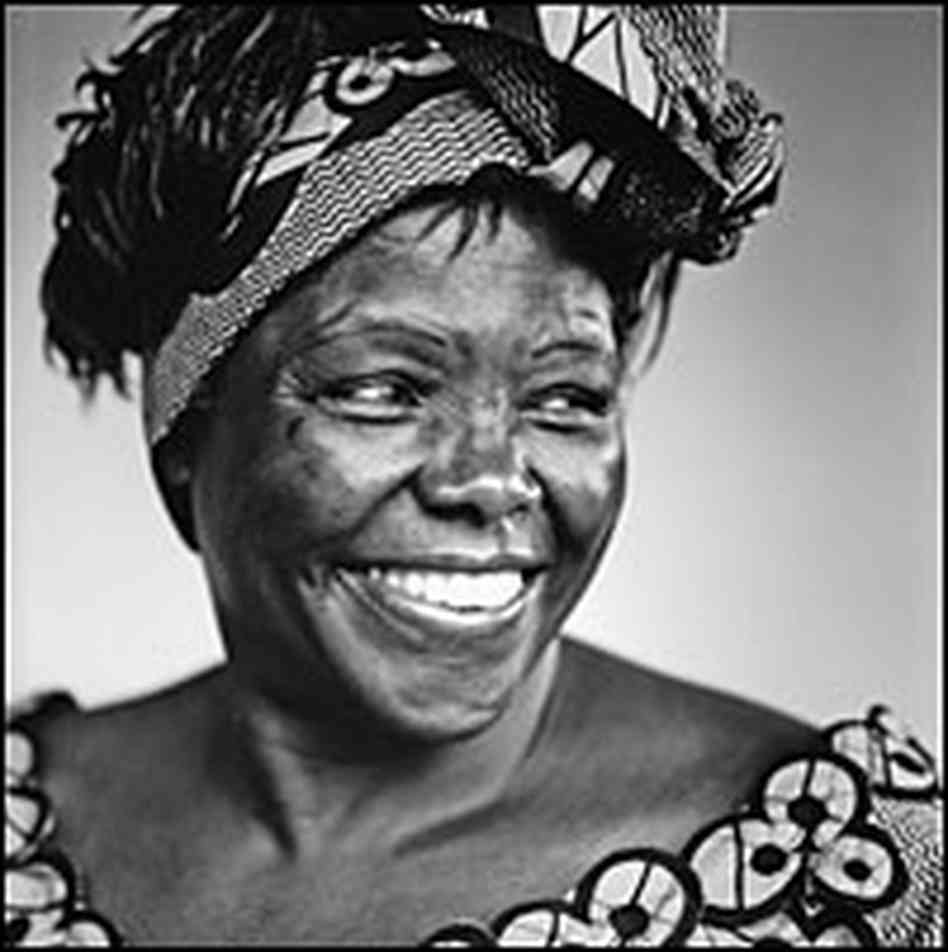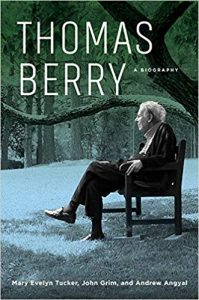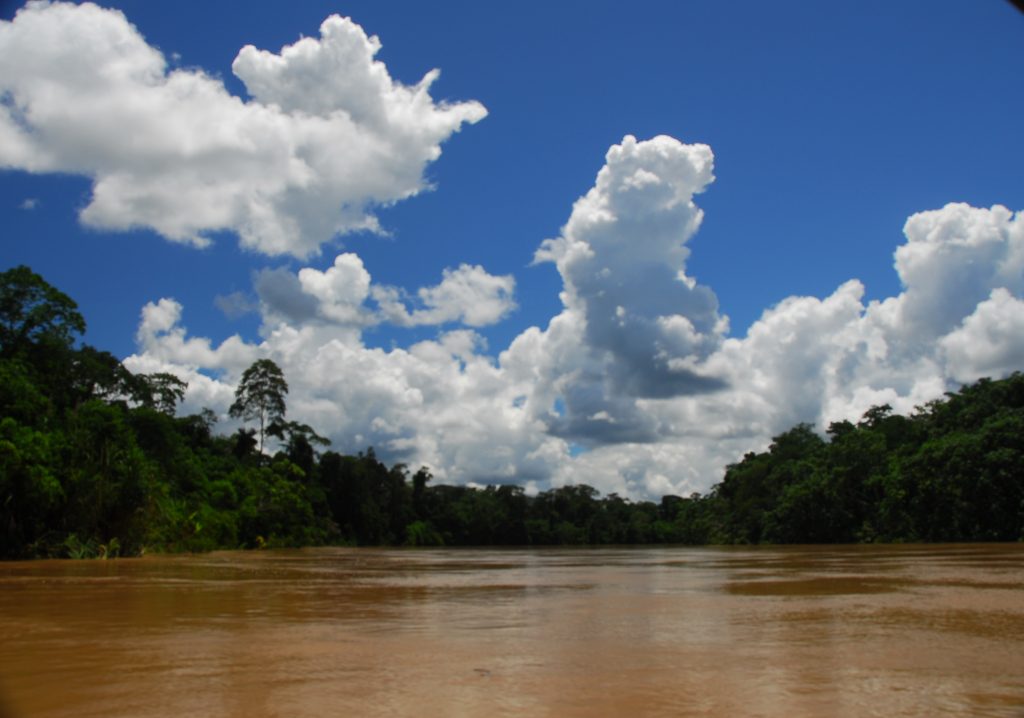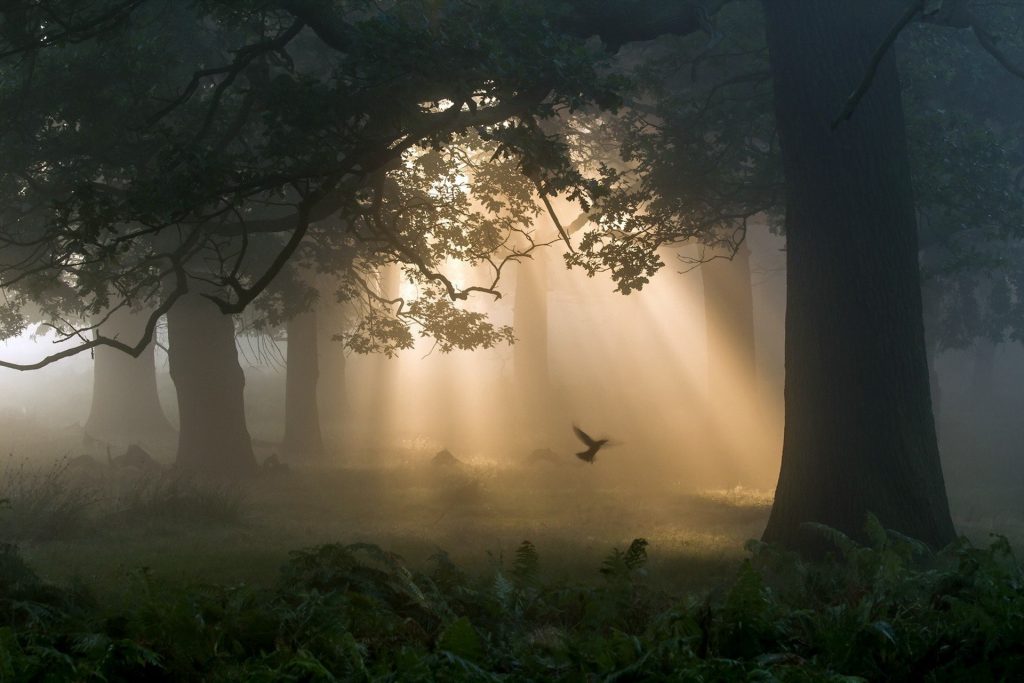Thomas Berry and the Rights of Nature
featured image: © User:Colin / Wikimedia Commons / CC BY-SA 4.0
One of Thomas Berry’s major contributions to what he called the Great Work was his articulation of the principles and philosophy of Earth Jurisprudence. He originated the term and explained its key concepts over many years.1 A Gaia Foundation report acknowledges: “Earth Jurisprudence is the term first used by cultural historian Thomas Berry to name the philosophy of governance and law, in which the Earth, not human interests, is primary. It accepts that humans are born into an ordered and lawful Universe, to whose laws we need to comply if we are to be a benign presence on Earth.”2 Thomas developed these ideas over several decades in conversation with others.
As he saw it, even the United States Constitution is fundamentally flawed by reserving all rights for humans and recognizing none for nature. For Thomas, the deficiency cries out for a fundamental transformation of our modern ideas of law. At the heart of this transformation, he noted, is the shift from a human-centered to an Earth-centered understanding of our relationship with the larger community of life. A profound change in perspective, he felt, would enable humans to recognize and protect the inherent rights of the natural world.
Given that the prevailing jurisprudence system does not protect other species or components of the living Earth, Thomas asked what would a different system look like? He pointed to various sources of inspiration, namely nature herself and indigenous peoples’ understanding of law. The starting point, he said, is recognizing that the laws of the Earth are primary. They govern life on the planet and human laws should be derived from these. This is clear for indigenous peoples whose languages, customary laws, and governance systems are rooted in the understanding that nature regulates the order of living processes in which humans are inextricably embedded. Thus, to maintain health and wellbeing for people and the planet, humans need to comply with the dynamics of nature. For indigenous peoples, the relationship between land and species is regarded as sacred and involves reciprocity.
Kosmos Great Thinkers and Seekers
Thomas Berry | Cultural Historian and Geologian
Written and narrated by Mary Evelyn Tucker and John Grim
Produced by Kosmos | (TRT 3:06)
Thomas Berry (1914–2009) was one of the twentieth century’s most prescient and profound thinkers. As a cultural historian, he sought a broader perspective on humanity’s relationship to Earth in order to respond to the ecological and social challenges of our times.
Berry urged humans to recognize their place on a planet with complex ecosystems in a vast evolving universe. He sought to replace the modern alienation from nature with a sense of intimacy and responsibility. Berry called for new forms of ecological education, law, and spirituality and the creation of resilient agricultural systems, bioregions, and ecocities.

That nature has rights within this worldview is not difficult to affirm because every component of life is an interdependent dimension of the web of life with inherent rights to exist. But since the language of rights evolved in a modern context, Thomas felt that humans need to acknowledge these biases in recognizing rights in a more-than-human context. These biases include a modern anthropocentric perspective, the objectification of the natural world, a view of the world as inert or even dead, and the assumption of human domination that emphasizes a use relationship with nature in the current industrial system.
Thomas was inspired early on by Christopher Stone, a law professor at the University of Southern California. Stone was one of the first to call for judicial reform, with his groundbreaking book in 1974, Should Trees Have Standing? Towards Legal Rights for Natural Objects.³ Stone argued for the rights of natural objects (trees) or ecosystems (forests, oceans, rivers) to have legal standing and to be represented by guardians to protect them, just as corporations and charitable trusts have legal representatives. He felt that these natural objects or systems should be recognized for their own worth and dignity, not merely their benefit to humans.
Thomas drew on this position of the inherent value of nature and of natural processes:
…every being has rights to be recognized and revered. Trees have tree rights, insects have insect rights, rivers have river rights, mountains have mountain rights. So too with the entire range of beings throughout the universe. All rights are limited and relative.4

Thus Thomas emphasized that: “Every component of the Earth community, living and non-living has three rights: the right to be, the right to habitat or a place to be, and the right to fulfill its role in the ever-renewing processes of the Earth community.5” This position has been foundational for many of those involved in formulating and making operational an effective rights of nature approach rooted in Earth Jurisprudence.6 Similar perspectives have arisen in the contemporary period with scientific understanding of the interdependence of Earth systems, particularly in ecology. Thus, by drawing on both indigenous and scientific knowledge, Earth jurisprudence is arising to respond to the needs of the larger community of life.
Emerging Developments of Earth Jurisprudence
Groundwork for the articulation of Earth Jurisprudence emerged with the United Nations’ World Charter for Nature in 1982. This was further developed with the Earth Charter issued in 2000 and the Universal Declaration of the Rights of Mother Earth in 2010. Thomas was especially appreciative of the World Charter for Nature. He felt it embraced a dynamic bio-centric perspective, and he built on this in his early articulation of the rights of nature.
In this spirit, in 1984, Thomas urged the Gaia Foundation in England to commit to the protection of biological and cultural diversity, restoration of healthy ecosystems, and support of indigenous peoples, especially in the Southern hemisphere.7 Inspired by a workshop led by Thomas more than a decade later at Schumacher College in 1996, the Gaia Foundation launched an Earth Jurisprudence initiative.8 This initiative involved a commitment to explore, develop, and promote pathways to affirm that Earth-derived law take precedence over human law to protect the wellbeing of all components of the Earth community.
In April 2001, the Gaia Foundation and Andrew Kimbrell, founder of the Center for Food Safety, organized a conference with Thomas Berry at the Airlie Conference Center outside Washington. A group of people involved with both law and with indigenous peoples came together from South Africa, Colombia, Britain, Canada, and the United States.9 One of those in attendance was the South African lawyer, Cormac Cullinan, who was inspired and encouraged by Thomas and the Gaia Foundation to write his path-breaking book, Wild Law: A Manifesto for Earth Justice, which was published in 2002.10 In the foreword, Thomas calls for the need for explicit legal protection of the larger Earth community. In December 2002, Thomas delivered this message in his plenary talk to an international conference on Earth Jurisprudence at Pace University Law School and its Academy for the Environment. Robert Kennedy, Jr., an environmental lawyer at Pace, was particularly influenced by Berry’s thinking. The following year, in October 2003, Thomas delivered the E. F. Schumacher Lecture in Great Barrington, MA titled “Every Being Has Rights,” which was received with enormous appreciation.11

In 2002, an African regional network was formed—the African Biodiversity Network—with one of its major priorities being to revive indigenous knowledge systems and their Earth Jurisprudence underpinning, inspired by Thomas and supported by the Gaia Foundation.12 In 2005, the Nobel Laureate, Wangari Maathai, and her legal adviser, Ng’ang’a Thiongo, campaigned, as advised by Thomas, to incorporate an Earth Jurisprudence preamble in the new Kenyan constitution.
In the fall of 2006, a major step forward in institutionalizing Earth Jurisprudence occurred with the creation of a Center for Earth Jurisprudence (CEJ) at the Schools of Law at Barry University and St. Thomas University in Florida. Sr. Patricia Siemen, an environmental lawyer and professor, was the founder and first director. Drawing on Berry, she has written on Earth jurisprudence in a cosmological perspective.13 The establishment of the Center was inspired by: “the processes and laws of the natural world that sustain all life forms, the writings of Thomas Berry and other environmental philosophers, lawyers and scientists, and the reverence and care for all of creation.”14
In 2008, the Center for Earth Jurisprudence created the Earth Law Center. Its first Executive Director, environmental attorney Linda Sheehan, advanced passage of new Rights of Nature laws, advocated for rights of rivers to flow, held local Rights of Nature Tribunals, promoted Rights of Nature before the United Nations, developed and taught an “Earth Law” class at Vermont Law School, and offered specific strategies to address the growing number of “co-violations” of nature’s rights, human rights, and the rights of indigenous peoples.15
Milestones in Implementing Earth Jurisprudence
Thomas’ notions of the rights of nature required the transformation of the dominant legal philosophy and principles, widening their ethical perspective to include the whole Earth community of which humans are a part. He often spoke of the need for principles, strategies, and tactics for transformation of individuals, society, and institutions. He and others realized that strategies and tactics leading to the enactment of the rights of nature would be difficult, but contrary to expectations, several significant breakthroughs have occurred. These began the year before Thomas died and have continued since.
In 2008, Ecuador adopted the Rights of Nature into its new constitution. Article 71 reads “Nature, or Pachamama, where life is reproduced and occurs, has the right to integral respect for its existence and for the maintenance and regeneration of its life cycles, structure, functions and evolutionary processes.”16
In 2009, the United Nations General Assembly proclaimed April 22 as International Mother Earth Day. In so doing, Member States acknowledged that the Earth and its ecosystems are our common home. The same year, the General Assembly adopted its first resolution on Harmony with Nature.17
On April 22, 2010, World People’s Conference on Climate Change and the Rights of Mother Earth in Cochabamba, Bolivia, approved the Universal Declaration of the Rights of Mother Earth. Over 30,000 people attended, representing more than a hundred nations. The vast majority present were indigenous peoples, especially from Latin America.18 As a follow up, in September 2010, individuals and organizations from four continents gathered in Patate, Ecuador. Out of this four-day meeting, the Global Alliance for Rights of Nature was formed.19
In December 2010, the first indigenous President of Bolivia, Evo Morales, and Bolivia’s Plurinational Legislative Assembly established the Law of the Rights of Mother Earth. The Law defines Mother Earth as “…a dynamic living system comprising an indivisible community of all living systems and living organisms, interrelated, interdependent, and complementary, which share a common destiny.”20 It calls on all people to “respect, protect and guarantee the rights of Mother Earth,” which is considered sacred in the worldview of Indigenous peoples and nations.
Several other watershed moments have emerged in the Rights of Nature movement. These include the adoption by the International Union of the Conservation of Nature (IUCN) at its 2016 meeting in Hawaii of a resolution calling for no development or extractive industries in Sacred Natural Sites and Territories and the recognition of customary governance systems. The IUCN in 2012 also committed to the Rights of Nature in its Resolution 100 and included action on Rights of Nature in its 2017-2020 work plan.
In New Zealand, the Whanganui River was the first in the world to receive legal personhood through a law passed on March 16, 2017.21 This was followed on March 21 by court recognition of legal personhood for the Ganges and Yamuna Rivers in northern India.22 Rights of Nature legal provisions also now exist in Colombia, Mexico, and dozens of municipalities in the United States, and are being debated in a number of other nations. Education in Earth Jurisprudence is also emerging.23 In April 2018, the Colombian Supreme Court ruled that stronger efforts must be made against deforestation in the Amazon and the country as a whole must be protected from the effects of climate change. In this ruling, the Colombian Amazon is granted personhood and thus is regarded as an entity with rights. This is the first such ruling in Latin America.24
Thomas’ contribution to this growing movement was his articulation of the principles of Earth Jurisprudence. This has influenced many individuals and organizations working to promote the Rights of Nature both in theory and in practice. Thus, in the areas of law and religion, as well as in other fields such as education and economics, agriculture, and bioregionalism, Thomas made significant contributions to actualizing the Great Work.
 Excerpted from the book, Thomas Berry | A Biography
Excerpted from the book, Thomas Berry | A Biography
By Mary Evelyn Tucker, John Grim, and Andrew Angyal
http://thomasberry.org/publications-and-media/thomas-berry-a-biography
Courtesy Columbia University Press | www.cup.columbia.edu
References
[1] This is confirmed by Mike Bell: “The need for a new jurisprudence was first identified by Thomas Berry who described destructive anthropocentrism on which existing legal and political structures are based as a major impediment to the necessary transition to an ecological age in which humans would seek a new intimacy with the integral functioning of the natural world.” Mike Bell, “Thomas Berry and an Earth Jurisprudence: An Exploratory Essay,” The Trumpeter, Vol. 19, no. 1 (2003). Bell, a community advisor for Alaska’s Inuit peoples, frequently visited Thomas in Greensboro discussing ideas and sharing writings.
[2] See history of the Earth Jurisprudence movement at Gaia Foundation: https://www.gaiafoundation.org/what-we-do/earth-jurisprudence/story-of-origin-growing-an-earth-jurisprudence-movement/full-story-of-origin/
And stored at Ecozoic Times: https://ecozoictimes.com/reinventing-the-human/earth-jurisprudence/history-of-earth-jurisprudence/
[3] Christopher Stone, Should Trees Have Standing? Towards Legal Rights for Natural Objects (Los Altos, CA: William Kaufmann Inc. 1974).
[4] Great Work, 5.
[5] Evening Thoughts, 149.
[6] The UN Harmony with Nature website lists experts who are committed to Earth Jurisprudence: http://www.harmonywithnatureun.org/knowledgenetwork/all-members/.
[7] In 1992, at the Earth Summit in Rio, the United Nations issued the Convention on Biodiversity, which helped support this perspective.
[8] Gaia Foundation: www.gaiafoundation.org
[9] Those attending included Liz Hosken, Ed Posey, Andy Kimbrell, Jules Cashford, Cormac Cullen, Brian Brown, Martin von Hilderbrand, and John Grim.
[10] Cormac Cullinan, Wild Law: A Manifesto for Earth Justice, 2nd Edition (Dartington, UK: Green Books, 2003).
[11] http://thomasberry.org/publications-and-media/every-being-has-rights
[12] africanbiodiversity.org
[13] “Earth Jurisprudence in a Cosmological Perspective” in Mary Evelyn Tucker and John Grim, eds., Living Cosmology: Christian Responses to Journey of the Universe (Maryknoll, NY: Orbis Books, 2016).
[14] www.earthjurist.org
[15] There is the rights-responsibilities distinction, under which indigenous peoples operate more pursuant to a responsibilities frame, with the rights frame more a “modern” human concept. See Catherine Iorns Magallanes and Linda Sheehan “Reframing Rights and Responsibilities to Prioritize Nature,” in Melissa Scanlon, ed., Law and Policy for a New Economy: Sustainable, Just, and Democratic (Northampton, MA: Edward Elgar, 2017).
[16] It is important to note that not all of the aspirations have been achieved in Ecuador. See Neema Pathak Broome & Ashish Kothari, “A Green Revolution Runs into Trouble,” Resurgence, No. 307 (March/April 2018).
[17] In subsequent years, Maria Mercedes Sanchez has been a leading force in the UN Harmony with Nature initiative, organizing annual Interactive Dialogues of the General Assembly. http://www.harmonywithnatureun.org/chronology.html
[18] It has also figured prominently in several International Rights of Nature Tribunals, the first of which was held in January 2014 in Quito, Ecuador. This was followed by International Tribunals in Lima, Paris, and Bonn, all held during the COP climate conferences, and Regional Tribunals held in Quito in Ecuador, in San Francisco and Antioch, CA. in the United States, and in Brisbane in Australia.
[19] www.therightsofnature.org.
[20] Bolivian Plurinational Legislative Assembly, Law of the Rights of Mother Earth, accessed at World Future Fund: http://www.worldfuturefund.org/Projects/Indicators/motherearthbolivia.html.
[21] New Zealand’s Te Urewara National Park had been granted the same legal status in July 2016.
[22] The Supreme Court of India later stayed the effect of the ruling pending the outcome of an appeal by the state government of Uttarakhand, which argued that its new responsibilities were unclear.
[23] In Africa, a three-year training for Earth Jurisprudence practitioners was initiated by the Gaia Foundation, to explore both the philosophy and practice, and an endogenous approach to working with indigenous communities to revive their traditional knowledge, customary laws, and governance systems. The first African Earth Jurisprudence practitioners graduated in July 2017, and a second group has embarked on their training. See https://theecologist.org/tag/earth-jurisprudence. This movement catalyzed the passage of a new Resolution from the African Commission, which recognizes sacred natural sites, ancestral lands and customary governance systems as rooted in Earth Jurisprudence. The strategy is to open spaces in the dominant colonial human-centered legal system in Africa for the recognition of its plurilegal systems, as promoted by the African Charter, which are derived from the laws of nature.
[24]Yessenia Funes, “The Colombian Amazon Is Now a ‘Person’, and You Can Thank Actual People” Earther.com, accessed April 14, 2018. https://earther.com/the-colombian-amazon-is-now-a-person-and-you-can-thank-1825059357.







